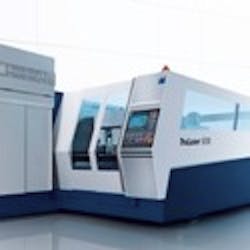Laser cutting machines
Farmington, CT - Starting at the end of October, standard machines in Trumpf's TruLaser Series 5000 will be able to cut through stainless steel up to 2 inches thick. In addition, when fitted with the BrightLine option, the 2D laser cutting machines considerably improve the quality of the edge on stainless steel sheet at gauges of between 0.8 and 1 inch. This is made possible with the TruFlow 8000, a CO2 laser that delivers 8 kW of power, and a mirror cutting head. The higher laser output is especially designed for shops that work stainless steel and aluminum.
With an 8 kW laser, fabricators can slice through aluminum sheet up to 1 inch thick. This is 0.2 inches greater than the same machine with 6 kW of laser power. Furthermore, it is up to 33% faster during fusion cutting with materials thicker than 3/8 inch. Machines featuring 8 kW lasers achieve the same increase in velocity in stainless steel, able to cut sheet metal up to 2 inches thick, which is twice the maximum thickness cut by the 6 kW laser.
To make full use of the laser’s high output, TruLaser machines with the TruFlow 8000 are equipped with a mirror cutting head. Since the heat-related effects are less than with lenses, the mirror-based optical system is reliable even if a considerable amount of dust has collected. As a result, cleaning is required less frequently and the wear rate at the mirror is distinctly less.
An additional benefit is found when the enhanced laser power is combined with the BrightLine function. This option uses a special mirror cutting head with a foot long focal length to produce clean and smooth edges, even in stainless steel up to 1 inch thick.
With its newly increased laser output, the machine is especially beneficial for companies processing a large quantity of thick-gauge stainless steel. Applications include making blanks for machining or cutting parts that could previously only be done with plasma or water jet equipment. With the ability to cut stainless steel up to 2 inches thick, the machine easily prepares blanks for subsequent machining operations. Instead of milling the part from bar material with a great deal of waste, the laser cuts the contour out of a plate of sheet metal. Here several different shapes can be efficiently nested together, saving material and machining time.
